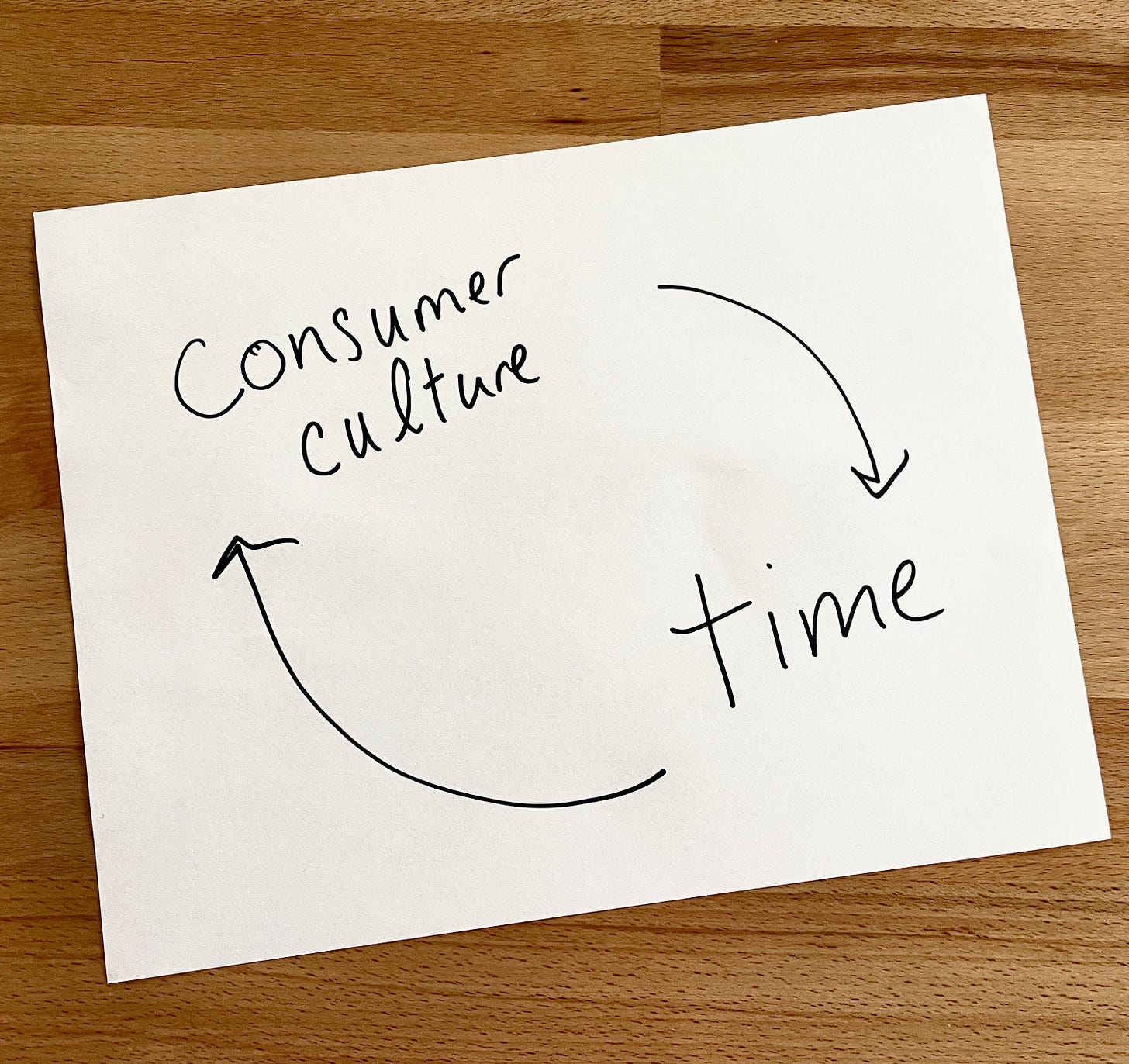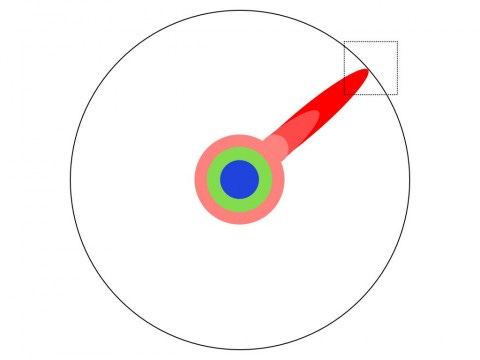How Fast Became Normal: Part 3
A brief history of time and consumer culture
Every Tuesday I post a short excerpt from my dissertation which explores the phenomenon of ‘social acceleration’ and consumer culture.
The last two weeks we talked about how consumer culture is fast (and the resulting consequences of a quick tempo) and also about the sociological thinking behind ‘social acceleration’ as a defining feature of the modern world.
The relationship between consumer culture and time is reciprocal.

Consumer culture reflects a sense of acceleration that we see in society more broadly. But marketing, as a socially and culturally-embedded system that distributes products and services and messages to the masses, also contributes to our orientation towards temporality. (This is the idea that “everything communicates” — which I’ll discuss more in a future post.)
This is the substack post that dips into a brief literature review, or recap of previous knowledge on time and consumer culture. In academic research, a literature review allows you to know what others have concluded about the topic you are researching, before you carry on your own research on the topic. After all, the aim of academic research is to create new knowledge, or to extend (or even challenge) previously held knowledge. (As an aside, I love this illustrated guide to getting a PhD - it perfectly captures the effort it takes to push current knowledge forward, even a hair.)

A literature review allows a solid ground for our exploration.
The marketing literature on temporality exhibits a broad range of considerations, from a focus on the subjective, consumer experience of time to a focus on the cultural, ideological dimensions of time.
From my review, I identified 3 key themes regarding time and consumer culture:
time is conceptualized as a scarce resource, giving rise to value notions of time and conspicuous consumption of time
consumers actively attempt to manage their consumption of time in everyday life
a logic of acceleration encapsulates all market-based activity, contributing to ideological norms in society
Let’s dive into each of those a bit further. (For readability, I’m going to edit down and reformat this section into bullet points, with a focus on the big ideas and important quotes from the reviewed text.)
—
Time as a scarce resource
In a modern world of plenty, the felt scarcities of time can be quite puzzling. In the early 1900s, it was speculated that folks living in the 2000s wouldn’t have to work more than 10-15 hours a week due to technological advancements. It was thought that we’d have ample time for leisure. This, largely, isn’t the case. (if you’re interested in specifics of how many hours US Americans work vs. spend on other activities, I always like to refer back to the American Time Use Survey.)
Leisure time indicates time spent not working. Consumption corresponds with time spent working.
The interwar period was crucial in determining the tradeoff between leisure time and consumption. Enlightenment thinkers decided our fate based on a paradox: “For some, prosperity undermined work effort and created the anarchy of undisciplined time; for others, it multiplied need and produced a work-driven society based on ‘false needs’”. Ultimately, society began to view the combination of general affluence and extensive freedom from work as a moral problem, and thus the latter viewpoint won out. This led to the emergence of a mass consumer society in the US and Western Europe.
Consumerism is now the basis of the modern economic order and public culture, and it also defines how most people organize their time around working and spending.
For the above reasons, consumption can be thought of as “a thief of time”.
Baudrillard views time as “invented as a commodity and for a commodity system”.
The stance that time is a commodity can be referred to as the “economicity of time”. The economicity of time asserts that people should allocate time in a rational, ‘wise’ way through rigorous scheduling and keeping of timetables and deadlines - treating time as an economic resource with a maximizable return. This is not how all cultures view time; it is uniquely Western.
The consumer experience of time
Consumers tend to place more value on time than money.
The expenditure of time is used to signal social status. Because US culture values the economicity of time, individuals derive social and personal benefits when they experience and signal busyness. Though individuals may feel some discontent with the demands of busy schedules, negative feelings are outweighed by the rewards granted by society. Such rewards incentivize a frenetic pace.
Individuals can temporarily alter their experience of time when engaging in specific consumption practices (downhill skiing vs. playing paintball, for example). This is referred to as “timeflow”.
Consumers can experience temporary states of perceived temporal deceleration through consumption practices, such as using a guided meditation app or walking on the Camino de Santiago.
Acceleration in the marketplace
Hastened temporality in the marketplace affects consumer desires and the pleasure experienced from consumption (for example, the introduction of ecommerce sites like eBay in the 90s fueled “accelerated cycles” of product discovery, never ceasing “to signal new possibilities”)
When consumers are able to quickly complete a purchase in this environment, it is possible they miss out on the opportunity of experiencing the pleasure associated with a state of desire; in other words, a faster pattern of consumption can actually be less desirable.
Analysis of AT&T advertisements in the early 20th century shows how new technologies normalized what it meant to be “modern”, including a shaping of modern concepts of time and space.
Consumers derive both functional and symbolic benefits from fastness in consumer culture. (e.g., in the context of fast food, the utility derived from a speedy service is one component; a product that allows a consumer the ability to keep up with an increasingly fast pace of life, and thus fit into social and cultural norms, another.)
The tl;dr of this entire literature review: A tempo of acceleration encapsulates the whole of contemporary consumer culture and actors within consumer culture respond accordingly.
—
^^This is life as we know it today. But is this how we want to live in the future?
I’m interested in exploring what it means to slow down and live a life marked less by consumerism. And as a marketer by training, I’m curious as to how an idea like that may be spread through traditional channels of cultural influence.
So for me, it is important to understand first how marketing contributed to our current hyperfast reality, so that in the future, perhaps marketing could contribute to a more enjoyable and sustainable temporality.
The important questions remain: How did fast become normal in consumer culture? And what is considered “normal” anyway?
Next week we’ll talk about how ‘cultural myths’ help normalize and pass down certain beliefs in a culture - including a brief history of the idea that “time is money”.
And after that, we’ll look at a bunch of old advertisements - reading them interpretively for their meanings around “time”. (Go ahead and sample a few below!)
See you on Thursday for an article on “de-influencing” and the theory of mimetic desire. It’ll be a good one :)









Thank you for this thought provoking article. It is an awakening of sorts to see what shapes us as we exist in the Western culture that shapes us. I look forward to reading more.